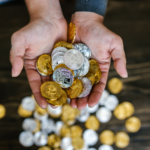NFT art is a new and upcoming form of digital art. It is unique in that it is stored on a blockchain, which makes it tamper-proof and secure. NFT art can be sold on various markets, such as OpenSea, Foundation, Mintable and Rarible. Each of these platforms accepts Ethereum for transactions.
The first step to selling your NFT art is to create a digital wallet for your artwork. This can be done on any number of websites, such as Metamask or Cipher.
These websites act as intermediaries between your NFT art and the markets where you want to sell them. After creating your digital wallet, you can add your artwork to it.
The next step is to find a market that supports the sale of NFT art. As mentioned above, OpenSea, Foundation, Mintable, and Rarible all support the sale of NFT. Once you find a marketplace you want to use, you can list your artwork. Be sure to set a price that you feel comfortable with, as you won’t be able to change it once the sale is complete.
Once someone has purchased your NFT art, the transaction will be processed on the blockchain. This means that the buyer will receive a token that represents his ownership of the artwork. The token can then be used to prove ownership or transfer the artwork to someone else.
Selling NFT art can be a great way to make money and showcase your unique digital creations!
In this article, we’ll discuss what NFT art is, how they’re helping artists, and delve into the details of how to really sell your NFT art.
Table of Contents:
What is an NFT art?
NFTs are seen as the future of ownership. Investors believe that all types of properties, from event tickets to homes, will eventually have their tokenized property status.
Non-fungible tokens, or NFTs, are fancy to say non-replaceable or one-of-a-kind. They make digital objects scarce, rare and extremely valuable. An NFT is a digital token that represents the ownership of a specific file or object, such as artwork, videos, gaming objects, or even real estate, and is stored on a blockchain.
The processes of creating and selling NFT artworks are complex and require both skill and determination on the part of the creator.
If you are interested in buying NFT, you can read our guide on How to buy NFT?
How are NFTs helping artists?
Many artists and designers are studying how to create and sell NFT art as a potential new source of income.
NFTs are helping artists around the world monetize their art. They earn more money through NFTs because they can receive a royalty whenever the NFT changes hands after the initial sale.
However, NFTs are more than just a new way of selling art; you can also use them to protect ownership of your digital assets, gain access to new communities, and even register ownership of physical objects.
4 Steps to Sell Your NFT Art
To start selling your NFT Art, you’ll need to create art from scratch or convert your existing artwork into a digital file.
You don’t need to do anything special when creating graphics since you can convert almost any digital file to an NFT as long as it is your original art.
But that’s not all you need to do, follow the steps below to start selling your NPTs today.
Step 1: Create a digital wallet
When selling NFT art, you will need to use a digital wallet to store your Ethereum. A digital wallet is a secure online platform that allows you to store your cryptocurrency. There are many different types of wallets available, so you’ll need to choose one that’s right for you.
Some of the most popular digital wallets include MetaMask, Coinbase Wallet, and MyEtherWallet. Each of these wallets offers different features and levels of security, so it’s important to research your options before choosing a wallet.
Once you’ve created a digital wallet, you’ll need to link it to an Ethereum address that you control. This allows you to receive payments from buyers when you sell your NFT art.
Step 2: Choose a Marketplace
Once you’ve created a digital wallet, you’ll need to choose a marketplace where you want to sell your NFT artwork. There are many different markets available, each with its own advantages and disadvantages.
Some of the most popular NFT marketplaces include OpenSea, Foundation, Mintable, and Rarible. These platforms accept Ethereum for transactions, so you will need to have an Ethereum wallet to sell your NFT art on these platforms.
Some NFT marketplaces are built on other blockchain networks like Solana, PolyGon, Flow, etc. And to sell on those markets, you’ll need native crypto coins to sell.
When choosing a marketplace for your NFT art, it’s important to consider factors like the fees associated with using the platform and the visibility your art will have on the platform.
No matter which market you choose, it’s important to remember that there is no “right” platform for selling NFT art. Ultimately, the best choice will depend on your unique needs and preferences as an artist.
However, before choosing a marketplace, research what file types the marketplace supports. Most marketplaces support traditional file types such as:
jpg, jpeg, gif, mp4, JPG, PNG, GIF, FVG, MP4, WEBM, MP3, WAV, OGG, CLB, GLTF.
Read our detailed comparison of the 10 best NFT markets to help you make the right decision based on your unique needs and preferences as an artist.
Step 3: Evaluate your NFT
NFTs are said to be worth only what people are willing to pay for them, but the truth is that certain factors influence their prices and how buyers value them. Therefore, evaluate your NPTs based on the following factors:
The average price of 30 days
This was the price trend of an NFT in any category. Ideally, your target price should be close to the average 30-day value of similar tokens.
Rarity
Some non-fungible tokens have distinctive features that will drive up their prices. Then give your NPTs an exclusive feature to make them unique. You’ll also need to boost your marketing campaigns to highlight the rarity score of your NFT collection.
Utility
You will be able to claim a higher price for your NFT based on the usefulness of the underlying asset. For example, if your NFT represents the right to use a digital service for free or at a discounted rate, you’ll be able to charge higher premiums.
Relationship between creators
Individuals who have established a reputation and following in the NFT space may be able to command a higher price for their assets.
It’s quite important to establish an online presence and distinguish your NFT collection with all the marketing resources available to promote your work. Your network of creators will play a huge role in promoting your collection.
Step 4: Create and List Your NFT Artwork
The final step in the NFT art sales process is to create your own artwork. When creating your NFT graphics, it’s important to consider factors like file size, texture, and visual appearance. In addition, you will need to make sure that you use a format compatible with the marketplace where you plan to sell your artwork.
Once you’ve created your artwork, you’ll need to upload it to the marketplace of your choice. When uploading your artwork, you will be required to provide some basic information about the piece, such as the title, description, and price. In addition, you will have to decide whether you want to sell your artwork as a single piece or as a collection.
After listing your NFT, keep an eye on offers from potential buyers. While most platforms will notify you when someone bids for your listing, it’s good to check in regularly to avoid missing out on any offers.
When someone buys your artwork, you will receive the payment in native cryptocurrency on your digital wallet.
And that’s it! You have successfully sold your first piece of NFT art!
Conclusion
Creating an NFT is not so challenging or diverse in terms of artistic talent, but figuring out how to sell them effectively can be very difficult. This is where experience and concentration come into play! You’ll need both if you want your artwork to be valued by potential buyers as if they were intended for their collection, which means there will never come a time when people won’t want what you’re selling because demand always keeps growing.


